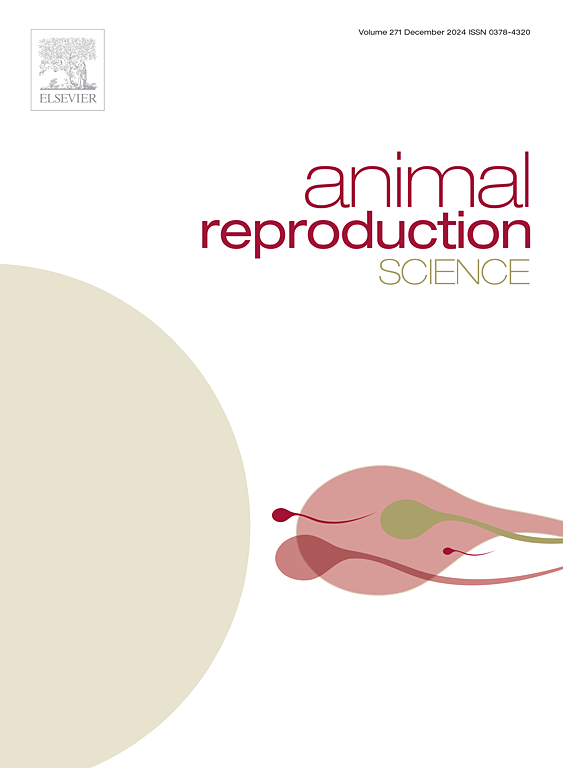PRM1 modulates proliferation, apoptosis, and testosterone synthesis in bovine Leydig cells
IF 3.3
2区 农林科学
Q1 AGRICULTURE, DAIRY & ANIMAL SCIENCE
引用次数: 0
Abstract
Testicular development is crucial for spermatogenesis and reproductive capacity of bulls. The synthesis and secretion of testosterone by Leydig cells influence testicular physiological functions. The protamine 1 (PRM1) gene is highly expressed in adult bull testes; however, its effects on bovine Leydig cells remain unclear. In this study, bovine Leydig cells were isolated and cultured, followed by overexpression and knockdown of PRM1. The effects of PRM1 on cell proliferation, apoptosis, and testosterone synthesis were assessed by quantitative real-time PCR, western blotting, Cell Counting Kit-8, EdU staining, flow cytometry, and ELISA. Overexpression of PRM1 enhanced cell viability, increased the proportion of cells in the S phase, and upregulated the expression of proliferation-related genes proliferating cell nuclear antigen (PCNA) and cyclin-dependent kinase 2 (CDK2) (P < 0.01); reduced the number of apoptotic cells and downregulated the expression of apoptosis-related genes BAX and Caspase3 (P < 0.05); and promoted testosterone secretion as well as the expression of testosterone synthesis-related genes cytochrome P450 family 17 subfamily A member 1 (CYP17A1), 17β-hydroxysteroid dehydrogenase 3 (HSD17B3), and steroidogenic acute regulatory protein (STAR) (P < 0.05). Conversely, PRM1 knockdown decreased cell viability, reduced the proportion of cells in the S phase, and downregulated the expression of PCNA and CDK2 (P < 0.01); increased the number of apoptotic cells and upregulated the expression of BAX and Caspase3 (P < 0.05); suppressed testosterone secretion along with the expression of CYP17A1, HSD17B3, and STAR (P < 0.05). Overall, PRM1 promotes cell proliferation and inhibits cell apoptosis in bovine Leydig cells, while enhancing testosterone synthesis and secretion. This study provides a theoretical foundation and potential applications for improving semen quality in bulls.
PRM1调节牛间质细胞的增殖、凋亡和睾酮合成
睾丸发育对公牛的精子发生和生殖能力至关重要。睾丸间质细胞的睾酮合成和分泌影响睾丸的生理功能。鱼精蛋白1 (PRM1)基因在成年公牛睾丸中高表达;然而,其对牛间质细胞的影响尚不清楚。本研究分离培养牛间质细胞,对PRM1进行过表达和敲低。通过实时荧光定量PCR、western blotting、cell Counting Kit-8、EdU染色、流式细胞术和ELISA检测PRM1对细胞增殖、凋亡和睾酮合成的影响。PRM1过表达可增强细胞活力,增加S期细胞比例,上调增殖相关基因增殖细胞核抗原(PCNA)和细胞周期蛋白依赖性激酶2 (CDK2)的表达(P <; 0.01);减少凋亡细胞数量,下调凋亡相关基因BAX、Caspase3的表达(P <; 0.05);促进睾酮分泌及睾酮合成相关基因细胞色素P450家族17亚家族A成员1 (CYP17A1)、17β-羟基类固醇脱氢酶3 (HSD17B3)、类固醇急性调节蛋白(STAR)的表达(P <; 0.05)。相反,PRM1敲低可降低细胞活力,降低S期细胞比例,下调PCNA和CDK2的表达(P <; 0.01);增加凋亡细胞数,上调BAX、Caspase3的表达(P <; 0.05);抑制睾酮分泌,抑制CYP17A1、HSD17B3、STAR的表达(P <; 0.05)。总的来说,PRM1在牛间质细胞中促进细胞增殖,抑制细胞凋亡,同时促进睾酮的合成和分泌。本研究为提高公牛精液质量提供了理论基础和潜在的应用前景。
本文章由计算机程序翻译,如有差异,请以英文原文为准。
求助全文
约1分钟内获得全文
求助全文
来源期刊

Animal Reproduction Science
农林科学-奶制品与动物科学
CiteScore
4.50
自引率
9.10%
发文量
136
审稿时长
54 days
期刊介绍:
Animal Reproduction Science publishes results from studies relating to reproduction and fertility in animals. This includes both fundamental research and applied studies, including management practices that increase our understanding of the biology and manipulation of reproduction. Manuscripts should go into depth in the mechanisms involved in the research reported, rather than a give a mere description of findings. The focus is on animals that are useful to humans including food- and fibre-producing; companion/recreational; captive; and endangered species including zoo animals, but excluding laboratory animals unless the results of the study provide new information that impacts the basic understanding of the biology or manipulation of reproduction.
The journal''s scope includes the study of reproductive physiology and endocrinology, reproductive cycles, natural and artificial control of reproduction, preservation and use of gametes and embryos, pregnancy and parturition, infertility and sterility, diagnostic and therapeutic techniques.
The Editorial Board of Animal Reproduction Science has decided not to publish papers in which there is an exclusive examination of the in vitro development of oocytes and embryos; however, there will be consideration of papers that include in vitro studies where the source of the oocytes and/or development of the embryos beyond the blastocyst stage is part of the experimental design.
 求助内容:
求助内容: 应助结果提醒方式:
应助结果提醒方式:


